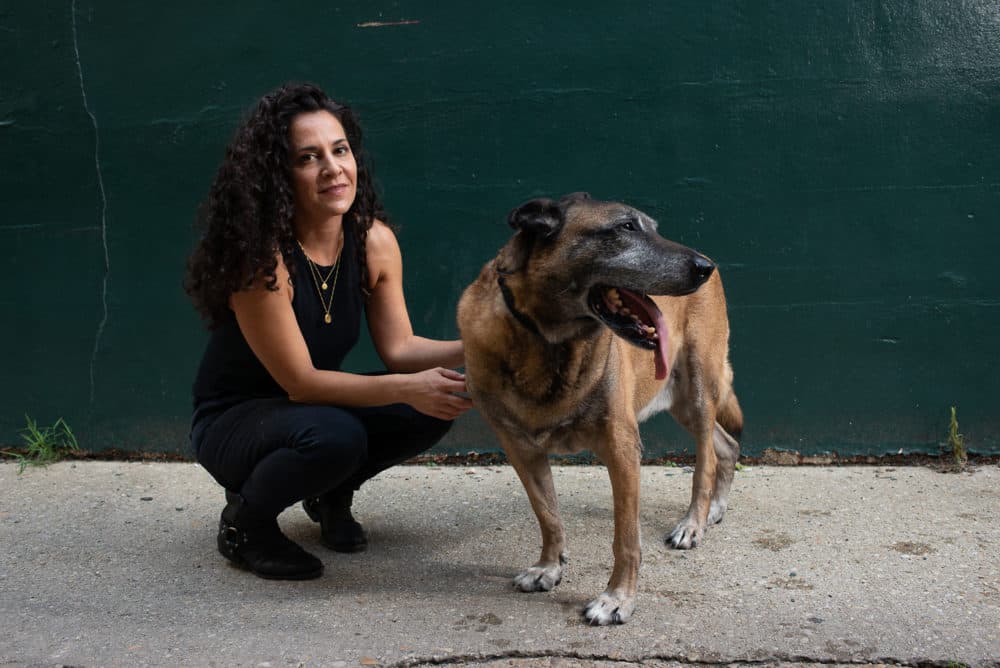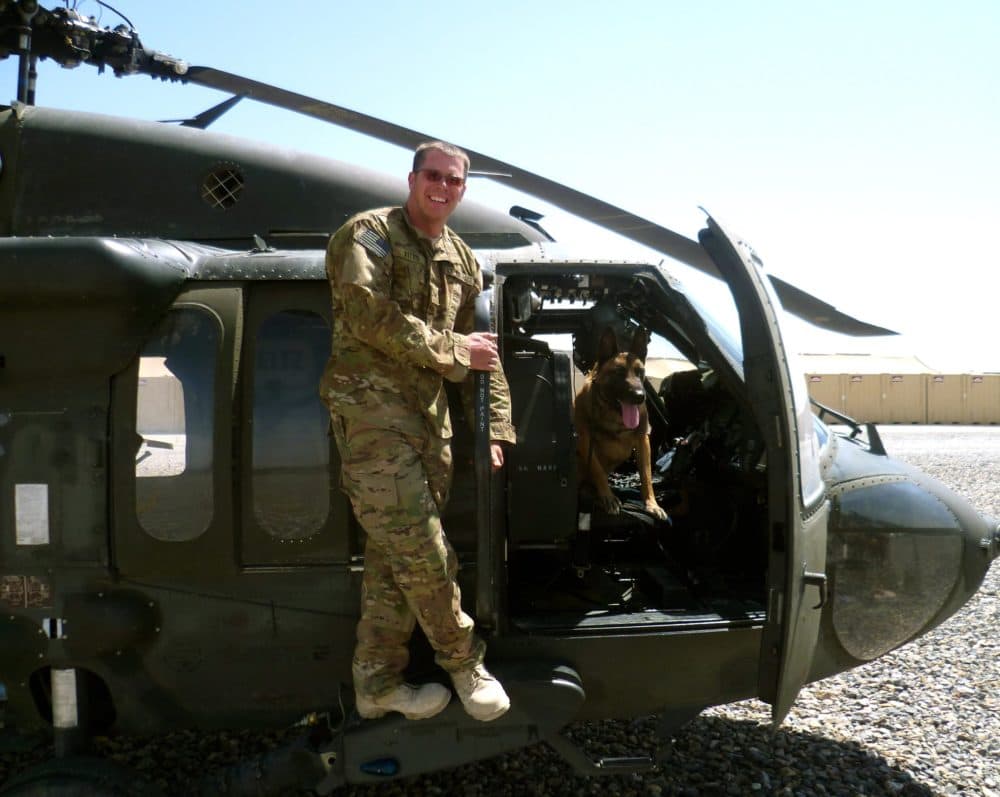Advertisement
War Zone To Walks In The Park: How A Dog Deployed Overseas Found A New Home
Resume
Nearly a decade ago, writer Rebecca Frankel started researching military working dogs — the intrepid canines deployed overseas to sniff out explosives or trap insurgents in caves. Her research led to the best-selling book "War Dogs: Tales of Canine Heroism, History and Love."
It also led Frankel to a retiring war dog named Dyngo, who needed a home.
What she quickly learned, however, is that the transition from battlefield to bedroom is not an easy one. Frankel (@becksfrankel) tells the story in an article for Smithsonian Magazine, including one memory of staying at a hotel after traveling cross-country to pick Dyngo up from Luke Air Force Base in Phoenix.
"I left him alone for about five minutes to take one of the fastest showers I've ever taken, and I came back out and he was sitting on the middle of the bed and he had just shredded these pillows, and so there were feathers everywhere," she tells Here & Now's Robin Young. "I just thought, 'Oh, my gosh, what have I done?' That was the first time I was seeing that side of him — Dyngo the Destroyer, as I sometimes call him now."
In Afghanistan, Dyngo worked through grenade blasts, firefights, helicopter rides and more. But as the dog's new owner, Frankel says his war-hero past isn't usually at the forefront of her mind.
"And I'm glad about that," she says. "I want him to just be a dog. I think that that's the big reward that he gets in life right now. But when I think about it, and writing and researching this article, I've learned more about him than I ever knew."
Interview Highlights
On how Dyngo's temperament has shifted since his time in the military
"It's interesting to think about that dog that I live with now ... who did all of these tremendous things and led really what is quite an amazing and remarkable life — much of the time spent sniffing for bombs in combat zones. Now, he is a mellow, sweet, loving, very affectionate and gentle creature. And in the course of reporting this story, I spoke to almost all of his former handlers and got a very different picture of a very different dog who was extremely hard-hitting in his bite drills, a voracious worker and really ... could be ferocious when he needed to be. So he's had a lot to deal with and a lot to combine together."
"It really shakes me out of the moment every once in a while, to sort of take a minute and realize that there are people who are walking around on this earth ... because he was there for them in the beginning."
Rebecca Frankel
On the challenges Dyngo's intense drive for toys posed
"The warning came sort of post-my adoption of Dyngo. But as one handler warned me, to be very careful with him when we're on a walk, because if he were to see a ball go out in the middle of the road — even if a Mack truck was coming — he was going to go after the ball, which sort of illustrates the incredible drive he has for toys, which comes from, during his training, using toys as the reward. So it's not that he just wants to play with a toy. It used to represent something a lot more deeply ingrained in him than that. And so his drive for it was just meteoric. I don't know how else to describe it. It was relentless."
On whether Dyngo had post-traumatic stress
"It's interesting because when I first adopted Dyngo, it was in the spring and July Fourth was not that far away, and I live in a pretty busy D.C. neighborhood where there are a lot of firecrackers that get set off. And we were out walking, and he doesn't respond to those things. So this anxiety and the difficulty he had adjusting to life as a house dog I think had a lot more to do with giving up his sense of purpose than I think it did with any truly traumatic experience."

On civilians adopting former military dogs
"It's something that I thought a lot about, especially at the beginning: whether or not I was equipped to be the person that Dyngo needed me to be, and to give him the home that Dyngo needed. I think what's required is a very clear-eyed vision of what it's going to be. In the end, I think what I was always searching for when I was struggling with Dyngo was to correct my own behavior. What are the things I'm not doing? I adjusted in the right ways. It just required a lot of consistency and patience."
On how she went about helping Dyngo adapt to his new life
"So the first thing that happened that was important was that I reached out for help and contacted someone who knew Dyngo very well, and that person was Justin Kitts. I called him that night when Dyngo and I were having this sort of face-off over a toy where I got scared, and he knew what Dyngo needed, and that was not a dog bed, but it was a crate, because Dyngo had always slept in a crate and that's where Dyngo felt safe, and I didn't have a crate ready, and that was my first mistake.
"And then I just decided that I had to do what was best for both of us to keep some sanity in the house, and for me that was setting up a routine: We get up at the same time. We took walks in the same place for the same amount of time. For about a month and a half, I came home every day at lunch to be the person that walked him during the day. And I took away all the toys, and then slowly, slowly reintroduced them back into his life until finally we got to a point where now there are toys out all the time."
On being reminded that her dog is a veteran and war hero
"It really shakes me out of the moment every once in a while, to sort of take a minute and realize that there are people who are walking around on this earth ... because he was there for them in the beginning. I've heard from them and I've heard from their parents, and it's special. He is very special."
Karyn Miller-Medzon produced this interview and edited it for broadcast with Kathleen McKenna. Jack Mitchell adapted it for the web.
This segment aired on February 4, 2019.
